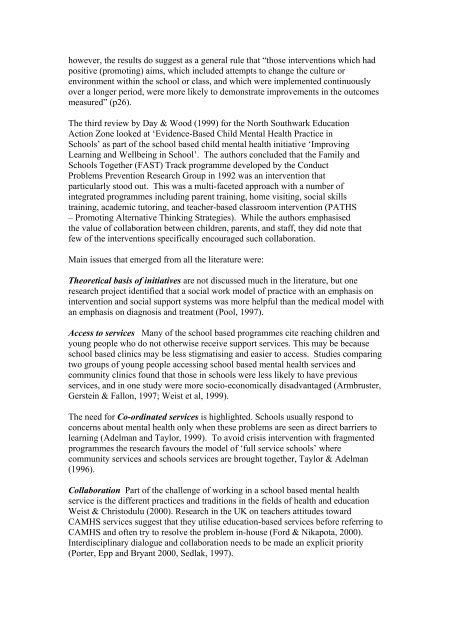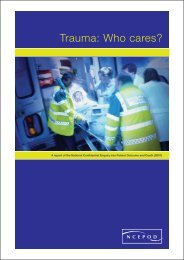(CAMHS) and Schools - London Health Programmes
(CAMHS) and Schools - London Health Programmes
(CAMHS) and Schools - London Health Programmes
You also want an ePaper? Increase the reach of your titles
YUMPU automatically turns print PDFs into web optimized ePapers that Google loves.
however, the results do suggest as a general rule that “those interventions which had<br />
positive (promoting) aims, which included attempts to change the culture or<br />
environment within the school or class, <strong>and</strong> which were implemented continuously<br />
over a longer period, were more likely to demonstrate improvements in the outcomes<br />
measured” (p26).<br />
The third review by Day & Wood (1999) for the North Southwark Education<br />
Action Zone looked at ‘Evidence-Based Child Mental <strong>Health</strong> Practice in<br />
<strong>Schools</strong>’ as part of the school based child mental health initiative ‘Improving<br />
Learning <strong>and</strong> Wellbeing in School’. The authors concluded that the Family <strong>and</strong><br />
<strong>Schools</strong> Together (FAST) Track programme developed by the Conduct<br />
Problems Prevention Research Group in 1992 was an intervention that<br />
particularly stood out. This was a multi-faceted approach with a number of<br />
integrated programmes including parent training, home visiting, social skills<br />
training, academic tutoring, <strong>and</strong> teacher-based classroom intervention (PATHS<br />
– Promoting Alternative Thinking Strategies). While the authors emphasised<br />
the value of collaboration between children, parents, <strong>and</strong> staff, they did note that<br />
few of the interventions specifically encouraged such collaboration.<br />
Main issues that emerged from all the literature were:<br />
Theoretical basis of initiatives are not discussed much in the literature, but one<br />
research project identified that a social work model of practice with an emphasis on<br />
intervention <strong>and</strong> social support systems was more helpful than the medical model with<br />
an emphasis on diagnosis <strong>and</strong> treatment (Pool, 1997).<br />
Access to services Many of the school based programmes cite reaching children <strong>and</strong><br />
young people who do not otherwise receive support services. This may be because<br />
school based clinics may be less stigmatising <strong>and</strong> easier to access. Studies comparing<br />
two groups of young people accessing school based mental health services <strong>and</strong><br />
community clinics found that those in schools were less likely to have previous<br />
services, <strong>and</strong> in one study were more socio-economically disadvantaged (Armbruster,<br />
Gerstein & Fallon, 1997; Weist et al, 1999).<br />
The need for Co-ordinated services is highlighted. <strong>Schools</strong> usually respond to<br />
concerns about mental health only when these problems are seen as direct barriers to<br />
learning (Adelman <strong>and</strong> Taylor, 1999). To avoid crisis intervention with fragmented<br />
programmes the research favours the model of ‘full service schools’ where<br />
community services <strong>and</strong> schools services are brought together, Taylor & Adelman<br />
(1996).<br />
Collaboration Part of the challenge of working in a school based mental health<br />
service is the different practices <strong>and</strong> traditions in the fields of health <strong>and</strong> education<br />
Weist & Christodulu (2000). Research in the UK on teachers attitudes toward<br />
<strong>CAMHS</strong> services suggest that they utilise education-based services before referring to<br />
<strong>CAMHS</strong> <strong>and</strong> often try to resolve the problem in-house (Ford & Nikapota, 2000).<br />
Interdisciplinary dialogue <strong>and</strong> collaboration needs to be made an explicit priority<br />
(Porter, Epp <strong>and</strong> Bryant 2000, Sedlak, 1997).

















